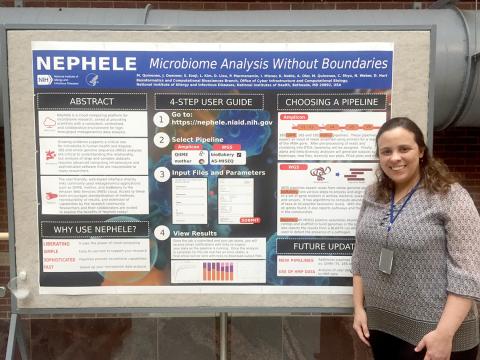ICs Show Off Latest Tech Tools at ‘Show & Tell’

In large agencies, any tool that might facilitate better data-sharing and faster turnaround is greatly appreciated. Several ICs unveiled an array of such IT solutions at the recent NIH IC Applications Show & Tell, sponsored by the NIH chief information officer.
Presenters from NCI, NHLBI, CIT, NIAID and OD demonstrated applications created to help the extramural, intramural and administrative management communities find, share and evaluate data. These innovative platforms, networks and repositories are promoting greater collaboration and efficiency, said Stacy Charland, NIH deputy CIO, during introductory remarks.
NCI-Frederick has developed a web-based, cutting-edge rendering tool that supports large-size image visualization. The tool displays 2-dimensional images of 3-D volumes, allowing mouse-finger image rotation and a JavaScript-based transfer function. It even works on older devices so investigators don’t need expensive equipment to view the images. Dr. Yanling Liu, who demonstrated this technology, said investigators also save time by not having to download the large files.
NIAID created a user-friendly, web-based interface for microbiome research called Nephele (https://nephele.niaid.nih.gov). Built on the Amazon Web Services cloud, Nephele helps researchers analyze large, complex datasets without having to struggle through complicated computing software and programs, explained NIAID’s Nick Weber. Designed by a team of software developers, analysts, computational biology experts and communication specialists, Nephele lets users view and compare genomic sequencing data and encourages reproducibility of results.
Another genomics tool is traC (Translational Research Application for Cohorts), based on the open-source tool transMART developed by NIAID’s Laboratory of Parasitic Diseases. TraC creates research cohorts and analyzes multiple research scenarios quickly, so users no longer have to spend months searching multiple disparate data sources to find the right datasets. This secure central data repository lets scientists view individual patient data and, using data curation and mapping features, follow patients’ progress over time.
NHLBI has a program to share pediatric trial data collectively and securely. The Pediatric Heart Network (PHN) Grid (www.phngrid.org, www.pediatricheartnetwork.org) supports a consortium of 30 children’s hospitals, a data-coordinating center and core labs that analyze ultrasound echo images, ECGs and clinical data submitted by PHN sites. The grid platform employs open-source image de-identification and image archive solutions to store and distribute clinical trials data to help investigators assess treatment therapies for congenital heart disease, said NHLBI’s Anna Fernandez. The grid contains image-based data for more than 3,000 patients across multiple PHN trials and uses MatchPlus to remove personally identifiable information before the data leaves the sites.
NCI also has a platform for researchers to share data, tools and other digital assets. NCIP Hub (www.nciphub.org) helps the cancer research community collaborate on these shared resources, serving as a collaboratory, said NCI’s Ishwar Chandramouliswaran. He said NCIP Hub serves as an outreach solution that can reduce costs by providing a digitized home for contributor-controlled content. More than 1,700 users are sharing hundreds of public and private resources and the site is growing.
SCS OnDemand is a web-based scientific coding solution managed by CIT. So far, six ICs are using this solution for scientific coding of NIH grants, contracts, intramural projects and intra-agency agreements. Each IC develops its own unique coding structure and process to reflect reporting and portfolio analysis needs and requirements, which are supported by SCS OnDemand. The system also allows participating ICs to categorize and report their portfolio as a formatted data feed to various NIH-wide reports, said CIT’s Rakesh Nayak and NCI’s Byron Adams.
OD has created a tool to streamline the job recruitment process. HR CARDS (https://hrcards.nih.gov), started in 2014, is a web-based repository for standard position descriptions and related classification and recruitment documents. The site contains more than 450 PDs for more than 80 different series. Vacancies are posted 4-5 days faster when using this system, said OD’s Nathalie Ivanovich-Rodriguez. Users can search by series, title, pay plan, HR CARDS number and keywords. There are multiple levels of access: non-HR personnel can search and view documents; HR specialists and administrators can modify records, run reports and delete/modify records or users.
NHLBI also demonstrated its Reporting Analytics Tool that facilitates advanced reporting and analytics, allowing users to create and review budgets and grants, travel reports, contracts, clinical research data and other reports across extramural and intramural programs.
If your IC has developed an application to enhance data sharing and collaboration, let the NIH Office of the CIO know about it: nihciocommunications@mail.nih.gov. The event was the third Show & Tell hosted by the NIH CIO, with another planned for this fall.
